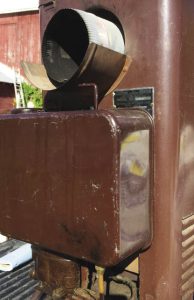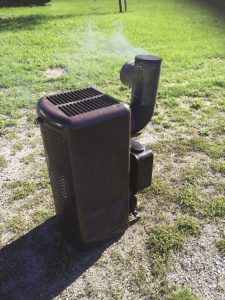
HPAC launched its What am I? contest in the October 2016 edition with a cropped image of a Coleman Oil Burning Heater, Model R-32-D.
The unit was manufactured in the late 1940s or early 1950s. This particular stove came out of the kitchen of a cottage that was constructed in 1947. At that time the cottage was 400 sq. ft. and its 35,000 Btu output certainly (over)did the job.
The winner was determined based on the accuracy and detail in the response, with bonus points for entrants who shared an interesting/amusing anecdote about the item. Our congratulations to Michael Smith; a Stanley TLM99 Laser Distance Measurer is on its way to you.
The winning entry
The item is an old fuel oil burning heater. It worked by the fuel flowing by gravity from the tank, which in this case is mounted on the back of the unit. The round protrusion is where the vent pipe attached to the chimney as it requires venting and natural draft for the combustion to work.
There is a carburetor on the back, which regulates the amount of fuel allowed into the combustion chamber. Many were hooked up to two hundred gallon tanks outside the home and raised so that the bottom of the tank was higher than the carburetor.
To light it, you lifted the lever on the carburetor up to start the oil flow. Then you threw in a lighted tissue or rag and closed the door. As the unit heated up, the heat would start to evaporate the liquid fuel and burn more efficiently. As the chimney heated up and drew more combustion air into the unit it would burn even better.
The style of carburetor did not change much, although I did see one designed to operate with a thermostat. The flame stayed on, but the thermostat would open the fuel flow on a call for heat.
Modern oil stoves of the 1990s had carbs, virtually the same as these much older units.
If you started one with too much oil in it, it would almost dance around the floor when it really got going. They were a very simple technology that burned quite clean when good fuel was used, and draft in the chimney was sufficient. Some people burned stove oil in these units.
We serviced several here in Grey County in the ’80s and installed a few of the new ones later. The new ones burned so well that you would have been excused if you had first thought it was gas. Michael Smith, Harvey R. Smith & Son, Markdale, ON
The source
Readers are invited to submit photos for the What am I? contest. Images must be jpeg or pdf format and a minimum of 300 dpi. If your image is selected you will receive a Stanley 25-ft. FATMAX tape rule.Thanks to Tom Aukstakalnis of High Mountain Mechanical in Eldorado, ON for a great photo to kick off our What am I? contest.
The contenders
⇒Re: October 2016 edition. The picture is an oil space heater. The oil is controlled by a float inside what is described as a carburetor. The oil flows into the bottom of the pot and is ignited by tossing in a lite piece of paper. These were used in homes as a source of heat. Unfortunately I do not know the manufacturer. When I first entered the trade as an oil burner technician I worked on a few of these. I witnessed one practically dancing around after lighting the oil unknowing that is was flooded with oil. Tom Tinsley, W.O. Stinson & Son Ltd., Arnprior, ON
⇒I just got my copy of the HPAC magazine and found this interesting question, “what am I.” The picture that you have is back side of a Quaker – Pot Burner Oil Stove. This unit burns #1 stove oil or kerosene best, but I still have one customer that uses #2 fuel in his and it works as long as fuel conditioner is put in the tank. The Quaker stoves were quite popular in barbershops back in the 50s and 60’s. The fuel is managed by the use of a carburetor. The fuel can either be piped in direct to the carburetor as long as there is enough gravity pressure to allow the oil to run to the unit. The picture that you have as an external tank on the back of the unit. In this case the owner would have to fill the tank from a fuel can every couple of days. Although this is considered old technology, the one thing that they did not need was electricity. Lyle McGill, Southampton, ON
⇒The picture you have in the October 16 edition is the back of an oil fired carbureted space heater. We currently still use a Coronado oil space heater, not quite as old as this one in our cabin still today. These units were used in several homes in our area many years ago but have become extinct now with the introduction of natural gas. Randy Bachmeier, Peace River, AB
⇒In your October 2016 magazine, I saw the What Am I” launch and I know what the product is if my memory serves me well. Back in the mid 1970s, I lived in the Yukon Territory in a small mining town called Elsa where I started my apprenticeship as a plumber. My supervisor, the late Fulvio Roberti was regularly fixing and calibrating oil-fired non electric space heaters used in some of the remote housing and cabins in the area.
What you are looking at is probably a Coleman vapourizing oil heater with an attached day tank. From the picture, this is the back of the unit and the dark brown piece below the chimney breech is the day tank (the fill cap is the flat black object on the left side). The gravity carburetor would be directly below the tank and the control mechanism and rod that controlled the flow of oil into the vapourizing pot inside the unit would be just beside the fill cap (the rod went down to the carburetor between the tank and heater exterior). These were great heaters and we sometimes had to adjust the burn rates depending on whether we were running #2 oil or for colder situations, #1 fuel that was more like kerosene.
My job, being a first year apprentice was less exciting in that I would first have to clean the pot burner inside that was often caked with thick layers of black, smudgy, dirty carbon. Did I say dirty, if not, I mean dirty. The carbon with its inherent oil residue would get onto everything and it would literally take days before my hands started to lose their gray tones and black finger nails.
Anyway, thanks for the (dirty) memories. Conrad Baumgartner, Ottawa, ON
⇒“I am an oil fire space heater. The tank attached to my back holds the oil which is rationed via a manual valve that lets the oil flow into my drum. When pooled at the bottom it is lit and burns creating heat. The opening at the top vents into a chimney. I am totally off the grid. P.S. My last memory is arriving at a scrap yard!” Kurt Heidebrecht, St. Catharines, ON
⇒The item is an oil space heater, you are looking at the back of the heater where the oil tank is, and the smoke pipe is above the oil tank, below the tank is the carburetor and the temp controls. There is a valve body that lets fuel in the combustion chamber, there are two float assemblies in the valve body in case one quits working for safety purposes. You had to light it with a match to start it working. If the fire would die it would fill the combustion chamber full of oil. They are used where there is no electricity. It is made by Enterprise, McLeod’s Hardware and Marshall Wells Hardware sold thousands of them in the ’50s. They were nicknamed “house burners,” because they caused a lot of house fires. Merv Kuharski, Neepawa, MB
⇒It is an oil stove made by Coleman, that in today’s day you would find in hunt camps and ice shacks! They used to heat homes but were banned quite some time ago. The tank at the back is filled with stove oil and a carburetor regulates the flow/drip of oil, and there is a dial on a rod that comes up from behind that acts as the thermostat. When these work, they work really well. The carb can be tricky but you can find an old school OBT he can make it purr like a kitten! Shawn Watson, Pembroke, ON
⇒It appears to be an oil fired space heater I had one that was made by Coleman that was a high end unit as it had a draft induction blower for improved combustion and a blower to circulate the heat from the heat exchanger. It required electricity where most did not. I think the tank that can be seen is for the fuel oil. The carburetor to control the fuel was the biggest source of problem if the float stuck and the oil flowed uncontrolled into the fire pot. There were stories of them dancing across the floor. George Pratt
Late but great entries:
⇒I was just going through the August issue again as we all do, meaning revisiting new products over and over again till our wives throw out the mags. Your pic on pg. 101 made me laugh. I made my garage in our first house into a work shop. With not a lot of $ to spare, I bought a oil space heater in the 100 dollar and under section as it was called then. I think I paid 60 dollars for it. It worked on stove oil, and just about anything else that would burn. The side had panels that swung open with the hinges at the back and I would put a 2′ x 2′ fan on one side so it would blow the warm air across the firebox.
It also had a hinged section on the front that swung down. That is where you gained access to the firebox to light it. I could not afford to properly vent this so I busted out a window, got some sheet metal and made my own thimble to run the vent outside. A little primitive but it worked. I believe the tank on the back held around 2 ½ gallons of fuel. It was a great little unit, very much like the one in my grand fathers cottage when I was a kid. We used to put our shirts on top of the stove so they would be warm to put on in cold weather. I don’t know how many had scorch marks on them over the years. It brings back good memories, don’t think I ever lost a shirt. A loyal reader, Steve Baxter
⇒The product featured is an oil space heater. You would find it in the house for room heating before furnaces. How it worked was the tank was filled with oil and the oil slowly siphoned into the burner. You controlled the heat by changing the volumn of oil flow into the burning chamber. These oil space heaters where made by Coleman.
Memories in the Sugar Shack:
Sometimes the carburetor would stick and the bottom of the tank would fill with oil and get red hot as the excess oil burned. The unit would start to dance in the room as the flames licked up the chimney pipe and the damper opened up drawing in cold air. The flames would then drop back down and the process would repeat itself making the stove dance and the pipes “whoosh” loudly. Scared the crap out of a guy and made it tough to hang onto my girl until the situation was remedied! George Palen






